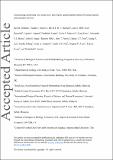Files in this item
Incorporating connectivity into conservation planning for optimal representation of multiple species and ecosystem services
Item metadata
| dc.contributor.author | Williams, Sara H. | |
| dc.contributor.author | Scriven, Sarah A. | |
| dc.contributor.author | Burslem, David F. R. P. | |
| dc.contributor.author | Hill, Jane K. | |
| dc.contributor.author | Reynolds, Glen | |
| dc.contributor.author | Agama, Agnes L. | |
| dc.contributor.author | Kugan, Frederick | |
| dc.contributor.author | Maycock, Colin R. | |
| dc.contributor.author | Khoo, Eyen | |
| dc.contributor.author | Hastie, Alexander Y.L. | |
| dc.contributor.author | Sugau, John B. | |
| dc.contributor.author | Nilus, Reuben | |
| dc.contributor.author | Pereira, Joan T. | |
| dc.contributor.author | Tsen, Sandy L.T. | |
| dc.contributor.author | Lee, Leung Y. | |
| dc.contributor.author | Juiling, Suzika | |
| dc.contributor.author | Hodgson, Jenny A. | |
| dc.contributor.author | Cole, Lydia E.S. | |
| dc.contributor.author | Asner, Gregory P. | |
| dc.contributor.author | Evans, Luke J. | |
| dc.contributor.author | Brodie, Jedediah F. | |
| dc.date.accessioned | 2021-08-10T23:39:17Z | |
| dc.date.available | 2021-08-10T23:39:17Z | |
| dc.date.issued | 2020-08-11 | |
| dc.identifier | 268708349 | |
| dc.identifier | 917929ac-ba74-49aa-9f6d-7c13fefde779 | |
| dc.identifier | 85089270189 | |
| dc.identifier.citation | Williams , S H , Scriven , S A , Burslem , D F R P , Hill , J K , Reynolds , G , Agama , A L , Kugan , F , Maycock , C R , Khoo , E , Hastie , A Y L , Sugau , J B , Nilus , R , Pereira , J T , Tsen , S L T , Lee , L Y , Juiling , S , Hodgson , J A , Cole , L E S , Asner , G P , Evans , L J & Brodie , J F 2020 , ' Incorporating connectivity into conservation planning for optimal representation of multiple species and ecosystem services ' , Conservation Biology , vol. 34 , no. 4 , pp. 934-942 . https://doi.org/10.1111/cobi.13450 | en |
| dc.identifier.issn | 0888-8892 | |
| dc.identifier.other | RIS: urn:4347C527D7BF82C3305C5658FC2B378D | |
| dc.identifier.other | ORCID: /0000-0003-3198-6311/work/79565031 | |
| dc.identifier.uri | https://hdl.handle.net/10023/23755 | |
| dc.description | Funding was provided by the Rainforest Trust foundation. Support was also provided by the Sabah Forest Department, Forest Research Centre, the South East Asia Rainforest Research Partnership, the U.N. Development Programme, the Universiti Malaysia Sabah (FRGS0414- STWN-1/2015), PACOS Trust, BC Initiative, the Natural Environment Research Council UK (grant NE/R009597/1), and the Universities of Aberdeen, Montana, and York. | en |
| dc.description.abstract | Current conservation planning tends to focus on protecting species ranges or landscape connectivity but seldom both – particularly in the case of diverse taxonomic assemblages and multiple planning goals. Therefore we lack information on potential tradeoffs between maintaining landscape connectivity and achieving other conservation objectives. Here we develop a prioritization approach to protect species ranges, different ecosystem types, and forest carbon stocks, while also incorporating dispersal corridors to link existing protected areas and habitat connectivity for protection of range‐shifting species. We apply our framework to Sabah, Malaysia, where the State Government has mandated an increase in protected area coverage of ∼305,000 ha but without having specified where the new protected areas will be. Compared to conservation planning that does not explicitly account for connectivity, our approach increased the protection of dispersal corridors and elevational connectivity by 13% and 21%, respectively, while decreasing the coverage of other conservation features by 0% (vertebrate and plant species ranges; forest types), 2% (forest carbon), and 3% (butterfly species ranges). Hence, large increases in the protection of landscape connectivity can be achieved with minimal loss of representation of other conservation targets. | |
| dc.format.extent | 913375 | |
| dc.language.iso | eng | |
| dc.relation.ispartof | Conservation Biology | en |
| dc.subject | Borneo | en |
| dc.subject | Climate change | en |
| dc.subject | Connectivity | en |
| dc.subject | Corridors | en |
| dc.subject | Deforestation | en |
| dc.subject | Habitat loss | en |
| dc.subject | Rainforest | en |
| dc.subject | Systematic conservation planning | en |
| dc.subject | QH301 Biology | en |
| dc.subject | NDAS | en |
| dc.subject | SDG 13 - Climate Action | en |
| dc.subject.lcc | QH301 | en |
| dc.title | Incorporating connectivity into conservation planning for optimal representation of multiple species and ecosystem services | en |
| dc.type | Journal article | en |
| dc.contributor.institution | University of St Andrews. School of Geography & Sustainable Development | en |
| dc.identifier.doi | https://doi.org/10.1111/cobi.13450 | |
| dc.description.status | Peer reviewed | en |
| dc.date.embargoedUntil | 2021-08-11 |
This item appears in the following Collection(s)
Items in the St Andrews Research Repository are protected by copyright, with all rights reserved, unless otherwise indicated.

